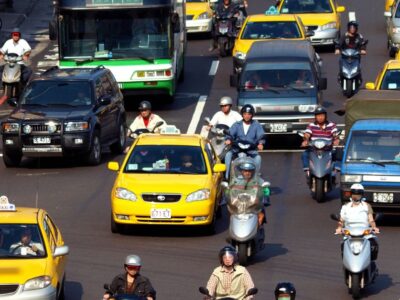“Lane splitting” is a term used to define any instance in which a driver shares space next to another motorist in the same lane. This term is most commonly used to describe situations in which motorcyclists split lanes to pass between lanes of slower-moving traffic. This may seem like a prudent move in certain situations, such as avoiding a rear-end collision with a driver in front of a motorcyclist who suddenly brakes. However, state law forbids lane splitting and similar actions, and engaging in lane splitting can lead to tickets or even reckless driving charges.
Why Is Lane Splitting Illegal?
In 2016, the state’s House Committee rejected a bill that would allow lane splitting in certain situations, citing safety concerns regarding the practice. California is the only state in the country in which lane splitting is technically legal, but even so, it is only legal in specific situations. Lane splitting can startle drivers, lead to serious accidents from lane changes, and disrupt the flow of traffic in several ways. For example, if a motorcycle splits a lane, but a driver ahead is about to change lanes, they could change lanes and cross the center line right as the motorcycle attempts to pass them. Since motorcycles are smaller than most other vehicles on the road, this makes them more vulnerable when they pass through other drivers’ blind spots.
Supporters of lane splitting typically claim that splitting lanes allows motorcyclists to move through slower-moving dense traffic, ultimately improving the flow of traffic for everyone in the area. In addition, when motorcyclists can split lanes legally, they can also move out of inclement weather or severe heat more quickly, both of which can be very dangerous to motorcyclists who are more exposed than passenger vehicle drivers.
What to Do After a Motorcycle Accident
If you or a loved one is involved in a motorcycle accident, it’s vital to know the first steps you must take to recover. Colorado is a fault state, so you must prove how your accident happened and identify the driver who caused the accident to succeed with any recovery efforts you attempt. In addition, the state requires all drivers to have liability insurance that comes into play when an accident happens, so the injured driver can file a claim against the at-fault driver’s insurance.
Insurance alone may not cover the full amount of your damages, however. Many motorcycle accidents result in tremendous damage to the rider, and it is possible for the motorcyclist to suffer catastrophic or fatal injuries. When insurance cannot fully repay your losses from an accident, you can pursue a personal injury claim.
In the event your accident happened because a motorcyclist was lane splitting, they are likely to absorb liability for the resulting damages since lane splitting is illegal. If you are unsure how to prove liability for your recent motorcycle accident, it is crucial that you speak with an experienced attorney as soon as possible. They can not only help you firmly prove fault for your accident but also help you recover more compensation than you might initially expect. The sooner you have legal counsel working on your case, the better your chances are of maximizing your compensation.
FAQs About Lane Splitting in Colorado
When Is It Legal to Lane Split on a Motorcycle?
Colorado law does not allow drivers to split a lane or share space in the same lane with another vehicle. However, the law does allow two motorcyclists to ride side by side in the same lane. While this presents some risks, it can actually improve rider safety in some situations, particularly at night. In addition, the taillights of the two motorcycles will mimic the appearance of twin taillights from a standard passenger vehicle, potentially making them more visible to other drivers behind them.
Is Lane Splitting the Same as Lane Filtering?
Lane splitting typically refers to a motorcycle passing between lanes of slower-moving vehicles, while lane filtering refers to a motorcyclist moving to the head of a pack of stopped vehicles. This enables them to be first in line to proceed when the traffic light changes. Lane splitting and lane filtering are both illegal in the state.
Who Is at Fault for a Lane Splitting Accident?
In the event that lane splitting causes a crash, the driver who splits the lane is responsible for the resulting damages. If you are unsure how to prove fault for a recent lane-splitting accident, it is crucial to speak with an experienced motorcycle accident attorney as soon as possible. They will know what evidence you will need to prove liability for the accident and how to recover your damages.
Do I Need to Hire an Attorney for a Motorcycle Accident Claim?
Technically, no, there is no law requiring you to hire legal representation for any civil suit. However, you will have a much better chance of winning your case with an experienced attorney’s assistance. Your attorney can help prove fault for the accident, file your auto insurance claim, and prepare a personal injury case against the at-fault driver.
What Happens When an Accident Happens From Illegal Misconduct?
If a driver causes a crash through lane splitting or some other illegal misconduct behind the wheel, they may face not only liability for the damages they cause in the accident but also criminal prosecution. They may be charged with reckless driving and face fines, driver’s license suspension, or even jail time. Penalties for reckless driving and other illegal actions behind the wheel increase significantly when those actions result in severe bodily injury or death.
The attorneys at Cheney Galluzzi & Howard have the resources and experience needed to answer any and all questions you may have about your legal options following a motorcycle accident. Our team has successfully represented many clients in a wide range of cases, and we are ready to provide the legal counsel you need for your impending case. If you’re ready to discuss your legal options with the help of a seasoned attorney, contact us now to schedule a free consultation.



 10 Things to Do After a Bicycle Accident in Colorado?
10 Things to Do After a Bicycle Accident in Colorado?